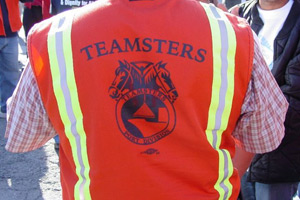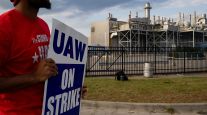Truckers Strike Against Four Southern California Fleets

Several hundred truck drivers at the ports of Los Angeles and Long Beach began a strike against four fleets, including two controlled by XPO Logistics, but there were no reports of interrupted cargo flow on the docks at the nation’s two largest ports.
The Justice For Port Drivers group, which is attempting to organize drivers to make them eligible for Teamsters union membership, said the action was taken against XPO’s Pacer Cartage and Harbor Rail Transport units as well as Pac 9 Transport, in Carson, California, and Intermodal Bridge Transport, a New Jersey-based company with operations in Long Beach. The announcement was made in a conference call, and organizers said 12 marine terminals and six rail terminals could be affected.
Spokesmen for both ports said operations were normal, though pickets were present at several terminals.
The action is the latest step that could disrupt the cargo flow in the nation’s two largest ports. Freight movement was cut by about half in the days leading up to a tentative agreement between the Pacific Maritime Association and the International Longshore and Warehouse Union that was reached two months ago.
“These are some of the biggest trucking companies in the port,” said Barbara Maynard, a spokeswoman for the group. “It is up to these companies to say ‘Yes, we will follow the law.’ The picket lines could come down in a matter of hours if the companies say they will follow the law.”
Some drivers seeking employee status at Pacer have won court cases, claiming they were misclassified as independent contractors. Those cases are being appealed.
“Independent contractors are used widely throughout the trucking business,” said a spokeswoman for XPO, which ranks No. 12 on the Transport Topics Top 50 list of the largest logistics companies in North America. “We are in regular dialogue with our independent-contract drivers and believe the vast majority of them value the significant benefits of operating independently. We’re committed to helping them succeed.”
The other strike targets didn’t immediately respond to requests for comment. Neither did the Union Pacific Railroad and BNSF Railway, which operate intermodal terminals in the region.
The group claimed workers at those companies should be classified as employees and that drivers routinely find funds deducted illegally from their pay as contractors.
Maynard said April 27 it was too early to determine how much impact the strike would have on port operations.
Based on cargo statistics provided by the ports, between 25,000 and 30,000 containers movie on and off the docks daily.
In recent weeks, port truckers have been unable to make their goal of three daily round trips to and from the docks. Cargo flow is being disrupted by congestion inside the terminals, triggered by inconsistent chassis supply and bunched-up cargo moves tied to arrivals of larger ships carrying cargo from multiple ocean carriers, according to harbor truckers.
Maynard explained that the pickets at port terminals and rail facilities were “informational” and targeted at drivers from the four fleets who were entering the terminals.
In addition, she said that the union and Green Fleet Systems, another drayage carrier, and the Teamsters have entered into a “labor peace agreement” that permits drivers there to vote on union representation while pledging to maintain normal operations.
The total number of drivers at the four fleets is about 500, she said.
Maynard also said it was too soon to tell whether the action could spread to other drayage fleets.
The last port truckers’ strike was in November.




